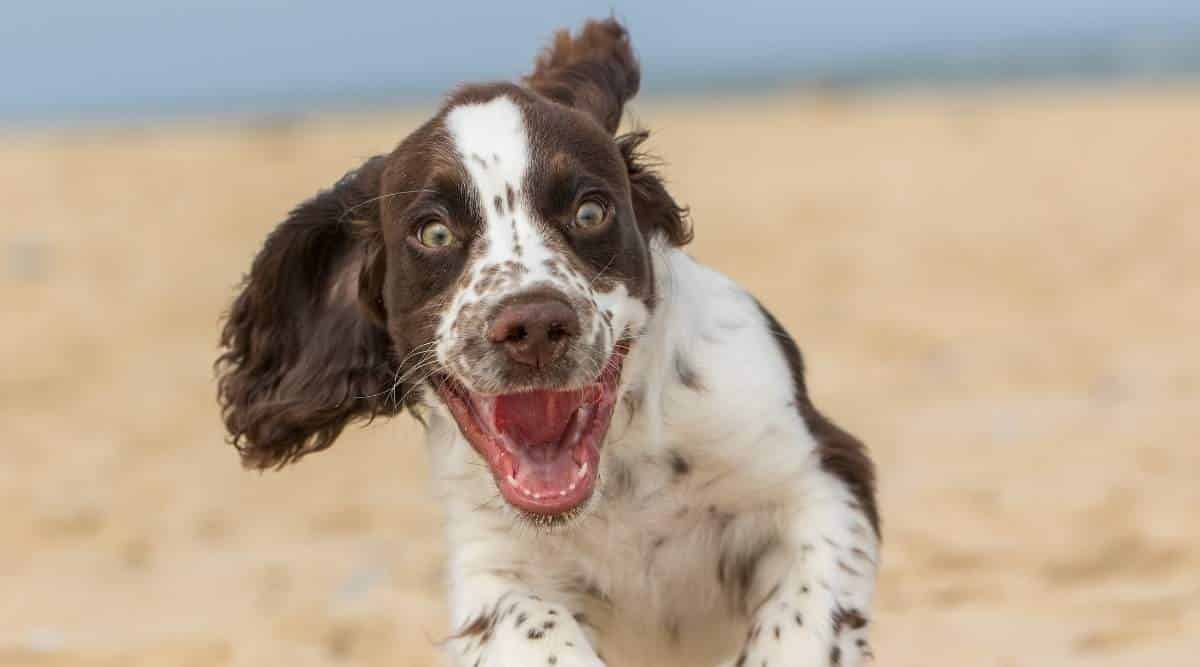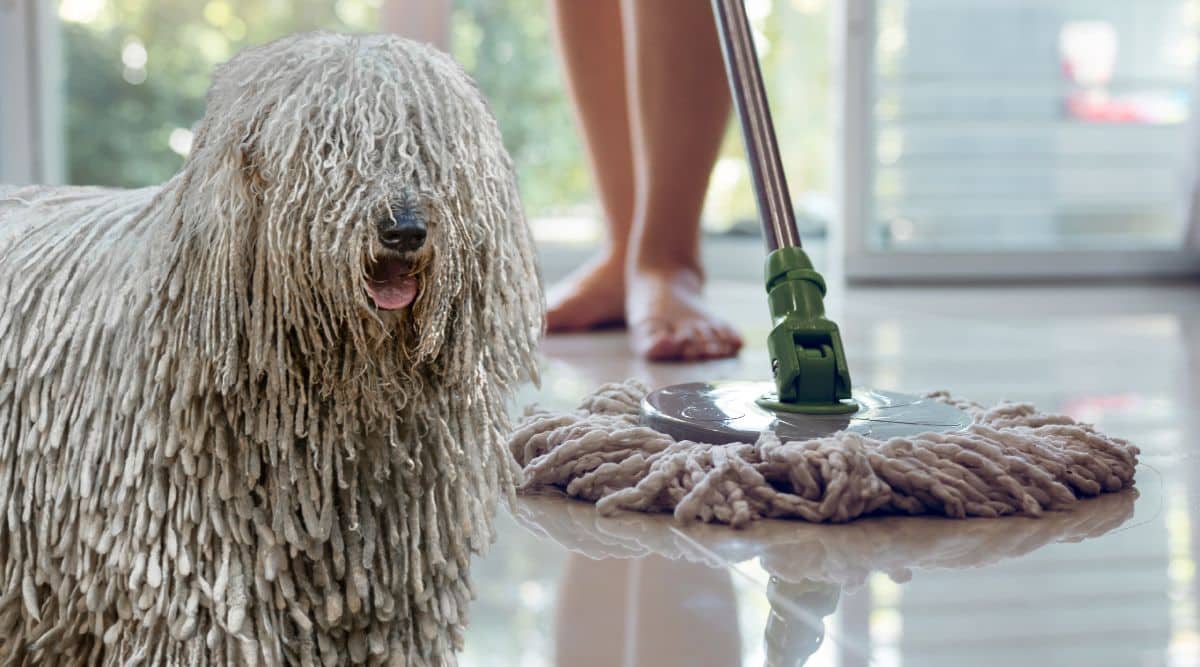Miniature Pinscher: Breed Facts, Traits, And More
When you purchase through links on our site, we may earn a commission. Here’s how it works.
Do you love the regal look of the Doberman Pinscher but have a small yard or no yard at all? Do you relish the idea of taking an easy jog or brisk evening walk with your best friend and having him turn heads with his jaunty, high stepping trot? The dog for you may be a German breed even older than the Doberman Pinscher. The Miniature Pinscher, or Min Pin, might be just your partner.
The Min Pin may be a small dog, but he is large in personality. Pinschers often seem unaware of their small size, and although he is a Toy breed, he is certainly not a toy. Fearless when protecting his loved ones, the Miniature Pinscher makes a surprisingly good guard dog. Despite his size, he sounds the alarm when a stranger approaches and will continue to bark as long as he senses a threat. Min Pins alert their families to any danger they detect.
A wonderful addition to an active family with older children, the Min Pin’s energy is boundless. When you head out on an easy jog around your suburban block or a brisk walk through the city park, he’s right there keeping up with you. A generally healthy, happy companion, Min Pins have a few quirks and health risks you’ll want to understand before you set out to purchase your new best friend.
Table of Contents
Breed History
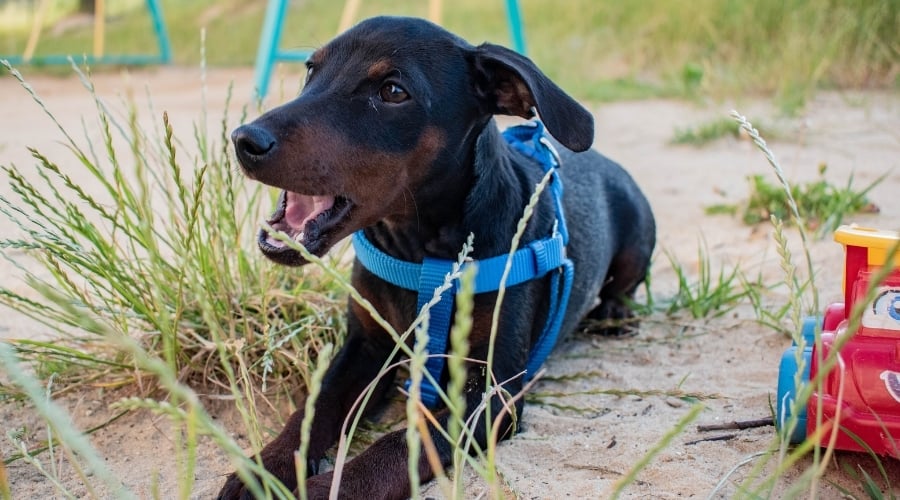
Like terriers in other countries, they were bred to hunt and kill rats in homes and on farms. The word “pinscher” simply means terrier in German and refers to the method by which they killed their prey. They would jump on the rat and “pinch” it with their jaws. These small dogs may have originally stemmed from a cross of Dachshund, Italian Greyhound, and possibly German Pinscher. They are actually older than the Doberman Pinscher breed, and despite the resemblance, the two are not closely related.
The Miniature Pinscher is part of the larger family of German pinschers (a type, not a breed). German pinschers varied by size and coat type, and in the mid-1800s, breeders began to define and separate the varieties into distinct breeds. They bred for the stability of size, large or small, and no longer bred smooth coated to rough-coated dogs. The Min Pin was once called the Reh Pinscher because he resembled Germany’s small red Reh deer. The German Pinscher family also includes the Affenpinscher and the Schnauzers.
In 1895, “Buch von den Hunden” by Bernard Wolphofer described the four varieties of Pinschers of the day. There were the rough-haired dogs, the Rough-Haired German Pinscher, and the Rough-Haired Dwarf Pinscher. Secondly, there was the smooth-coated pair, the Smooth-Haired German Pinscher, and the Short-Haired Dwarf Pinscher, which we now know as the Miniature Pinscher.
Temperament
These dogs efficiently eliminated rats on the farmstead, which explains their high prey drive today. They may be tempted to give chase to smaller pets and even children. Min Pins have a tremendous amount of energy and tend to push the envelope of what they are allowed to get away with. A firm but gentle approach to basic obedience commands will help keep him from running the household.
Min Pins tend to resource guard their food and toys. This may not cause many problems in a single animal household, but as soon as another animal or human enters the picture, they may challenge the interloper. Although Miniature Pinschers may show food aggression, they can be taught to relax and accept that their food is safe with proper training.
The Miniature Pinscher is proud and playful even in old age. His independent streak will challenge his trainer, but he is never boring. Clever and curious, he may spend the day looking for ways to entertain himself if you are not home, so providing him with sufficient toys and exercise time is a must.
Size And Appearance

Members of the AKC Toy Group, Min Pins stand between ten and twelve and a half inches at the shoulder. These little dynamos weigh between 8 and 10 pounds. Miniature Pinschers stand proudly at attention, and their distinctive gait catches the eye of anyone who sees them pass. They move with the animated step of the Hackney harness horses and ponies who once pulled stylish carriages through European streets. The hackney gait of the Min Pin captures the class and elegance of times gone by.
Coat And Colors
Many people mistake the Miniature Pinscher for a close relative to the Doberman Pinscher because of his coat and color. Breed standard dictates he be black and tan, black, and rust, chocolate, and tan, chocolate and rust, red, or stag red. His low-maintenance smooth coat sheds minimally.
Exercise Requirements
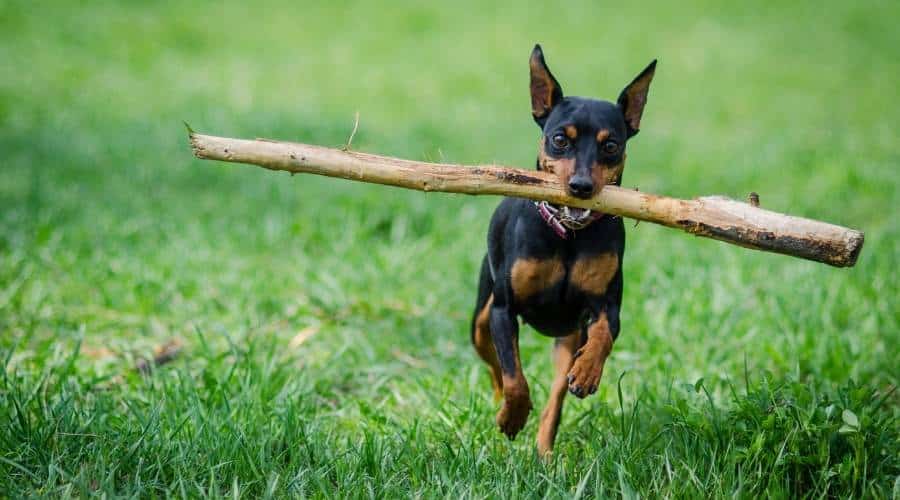
Although the Min Pin requires plenty of activity to stay healthy and happy, his compact size means his exercise requirements can be fulfilled either indoors or outdoors. He’ll enjoy relaxing on the sofa and snuggling on a chilly day but will be at least as excited to go outside and fetch tennis balls or just stretch his legs and run.
Excess weight is an issue in the Miniature Pinscher, so he needs daily good game sessions to keep him active even if he is stuck indoors due to bad weather. Although he loves a good outdoor run at the dog park, his thin coat won’t keep him sufficiently warm. He’ll learn to appreciate a well-fitting dog jacket on bitter mornings, but be sure not to leave him out unattended in it lest he hang it on something and become trapped.
Living Conditions
The Min Pin is not meant for outdoor living because he’s not equipped for extremes of temperature. He’s fond of sleeping on a warm bed, under covers, and snuggling with his family. His needs for space are minimal. If he has the opportunity for daily walks with you and the occasional run in the park, he is perfectly content as an apartment dweller. He will need protection from cold weather because his coat is so sleek.
Training
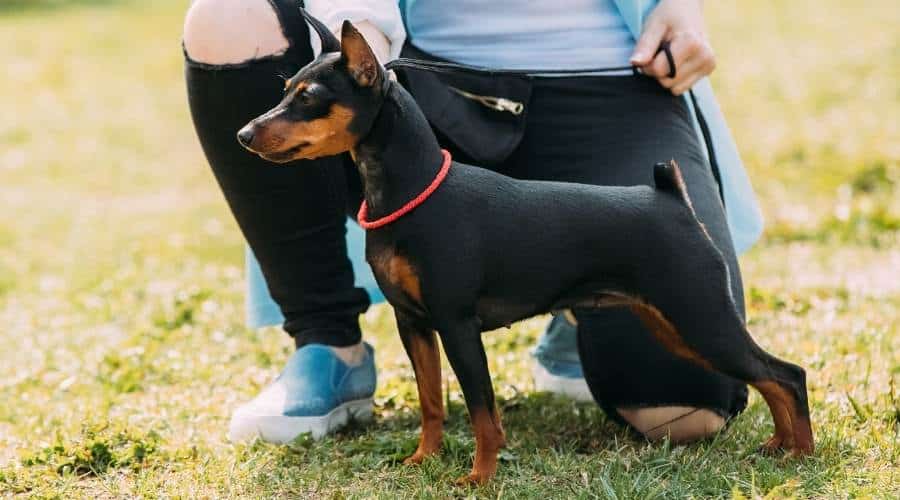
They may test their boundaries. Spend time with your pup teaching him basic obedience commands, and keep him well-exercised, so his frustration doesn’t get him in trouble.
Crate training your Min Pin gives him a safe space to call “his” within your home. It will also help as you housebreak your new pup, especially if you bring him home in the winter. He may not want to go outside to use the bathroom if it is particularly chilly.
Health
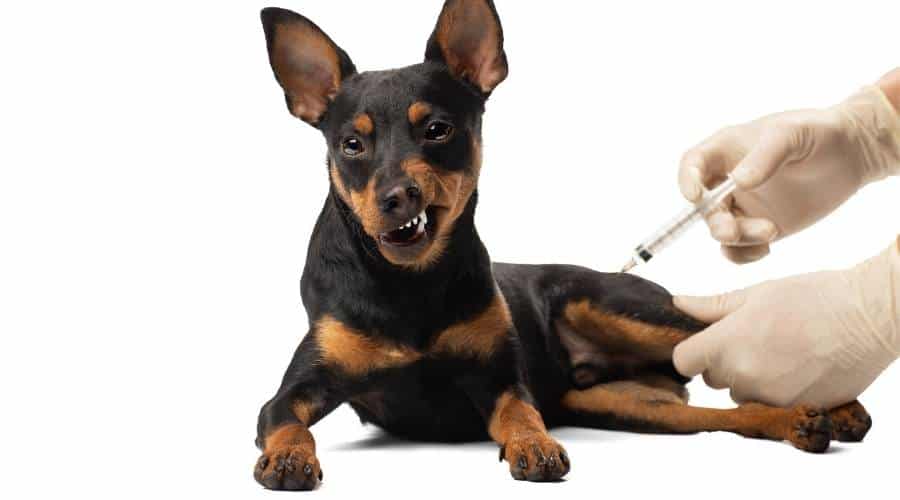
While Miniature Pinschers are a long-lived breed, reaching the age of 12 to 16 years.
Mucopolysaccharidosis
Also known as MPS IV, Mucopolysaccharidosis is a “rare inherited metabolic disorder that results in cellular dysfunction.” A specific genetic mutation is responsible for this debilitating disease in Miniature Pinschers, and breeding dogs should be screened for it. Symptoms of MPS IV in dogs include delayed growth, progressive corneal cloudiness, and skeletal deformities. If a puppy is born with MPS IV, he will require intensive nursing care and may need to be euthanized at a young age.
Patellar Luxation
Just like in people, the patella is the knee cap. The patella sits in a groove at the top of the shin. A luxating patella slips in and out of this groove, dislocating and stopping the knee from bending properly. Not only does this cause lameness, but it can also cause pain and arthritis.
Luxation of the patella is usually a genetic condition. Although it typically affects small breeds, it can be found in larger dogs. If you notice your dog holding a leg up for a few steps as he runs but then he uses it normally again, make plans to take your dog to the vet to check it out. This condition can lead to stiffness and arthritis later in life. Treatment varies with the severity of the condition. Mild cases of patellar luxation may be treated with NSAIDs to alleviate discomfort. In severe cases, however, surgery will be the recommendation.
Legg-Calve-Perthes Disease
Miniature Pinschers are prone to Legg-Calve-Perthes disease. This devastating disease typically affects small dog breeds in their first year of life. The disease causes the ball at the top of the femur to lose its blood supply, and it breaks down inside the hip joint. This condition is serious. Surgery to remove the ball of the femur can save the animal, but complete hip replacement may prove necessary.
Epilepsy And Seizures
Epilepsy causes seizures in affected dogs. The exact cause of epilepsy is unknown, but a genetic basis is suspected in many breeds, including the Min Pin. Generalized seizures are more common than focalized seizures. Your buddy may stiffen or stumble. While seizing, he may fall, drool, move his legs uncontrollably, lose control of his bladder and bowels, and tremble. He may cry out. Seizures last on average 30-90 seconds. As frightening as they may be for you, your pet may be unaware of what is happening during these periods.
Fortunately, medication can mitigate seizures. Most dogs tolerate the anti-seizure medication and are able to resume a normal lifestyle, although some continue to have breakthrough seizures. Your veterinarian will be your best resource as you and your buddy navigate his treatment.
Heart Defects
Min Pins can suffer from heart defects. When you are in the market for a puppy, be sure you’ve established a relationship with a veterinarian that can check over your new pup for you and work with a reputable breeder who screens for genetic disorders. Heart failure is a leading cause of death among older Miniature Pinschers. If your dog develops heart valve disease, he will probably have a heart murmur which your veterinarian will diagnose and monitor year to year. If heart valve disease is diagnosed early, medication may be able to preserve your dog’s quality of life for a longer time.
Eye Problems
Miniature Pinschers are prone to several eye problems. One such issue is glaucoma, which occurs when fluid cannot drain properly from the eye. The increased intraocular pressure leads to blindness if left untreated. Glaucoma is painful, and symptoms include tearing, squinting, corneal opacity (the clear front part of the eye becomes cloudy), and redness in the whites of the eyes. As glaucoma advances, the eye may look like it’s swollen or bulging. When you take your new pup to the vet, discuss annual eye screenings to help protect your buddy’s vision.
Miniature Pinschers also have issues with cataracts and PRA. Cataracts tend to appear with age. While surgery is an option for this disease with its recognizable cloudy appearance, many elderly dogs adjust to blindness as long as their owner makes accommodations. If your dog appears to be losing his sight and there are no visible cataracts, he may have Progressive Retinal Atrophy.
One of the most frightening aspects of PRA is that it is asymptomatic until significant loss of sight has already occurred. Your buddy may be unwilling to go into a dark room or may bump into things in a new environment. Visually, you have little to go on other than his retina, or retinas may seem shinier than normal. If you notice your dog acting like he struggles to see, make an appointment to have him screened. Unfortunately, there is currently no cure for PRA, but you can modify his environment to make things easier for him.
Thyroid Problems
When the dog does not produce sufficient thyroid hormone for the body to function normally, we say he is hypothyroid (hypo means under, so this quite literally means thyroid under normal levels). Symptoms include lack of energy, hair loss, changes in behavior, and obesity. Because obesity is a common problem in Min Pins, see your veterinarian if your overweight dog presents any of these other symptoms. He or she may prescribe a hormone supplement to balance the deficiency.
Nutrition
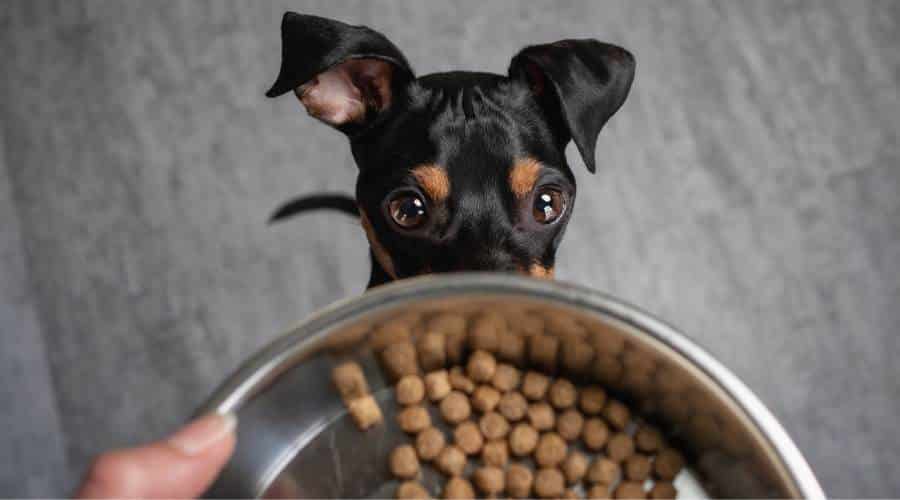
Proper nutrition for your Min Pin puppy means choosing the right type of food with the right content at each stage of his life. When he is a puppy, feed about a half-ounce of puppy food for each pound of body weight. He will be small, so make sure the size of the kibbles you offer him is not too much for his puppy teeth to chew effectively.
As he grows, graduate him to an adult dog food balanced for toy breeds. Miniature Pinschers tend to put on excess weight, and it can ruin your dog’s health. Avoid feeding high-calorie treats. If your dog starts to gain excessively, you may switch to a weight control food, so his intake is the same volume-wise but lower in calories.
Increase his exercise regimen unless he seems stressed. If the additional 15 minutes of ball toss or brisk walking is wearing him out, make a visit to your veterinarian to screen for thyroid issues.
Grooming
The Miniature Pinscher’s short, hard coat is easily maintained by a weekly once-over with a soft brush or a hound glove. Coat care for this breed is minimal. With a new puppy, spending time together in grooming sessions helps accustom him to your touch and is an opportunity for the two of you to bond. As he learns to trust you, the grooming necessaries dogs enjoy less, such as having nails trimmed or teeth brushed, will be easier on your both.
Breeders And Puppy Costs
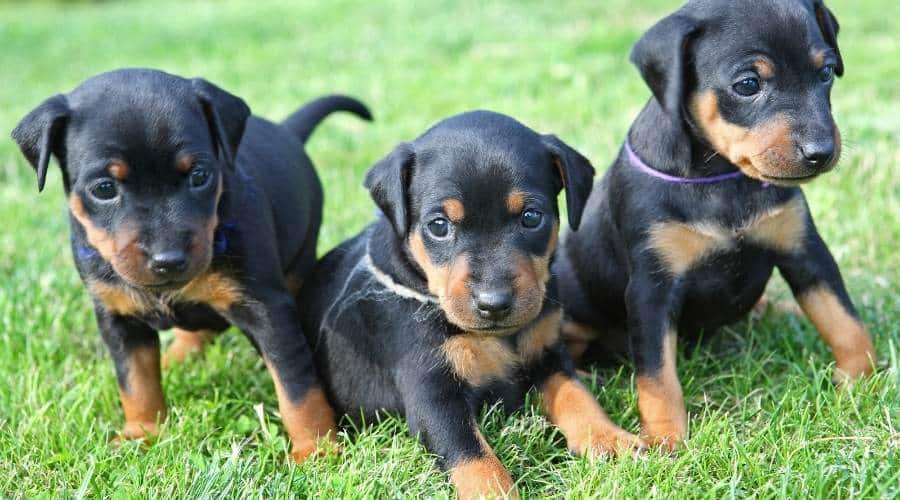
You may expect to pay from $1,000 to $2,000 for a Miniature Pinscher from a breeder. Show quality dogs will cost even more. Be sure the breeder you choose stands behind the health of his or her dogs.
Rescues And Shelters
You might consider adopting your new best friend. Visiting a local animal shelter is a great way to meet the adoptable dogs near you. If they don’t have any Min Pins available, they might be able to check nearby shelters for you. There are well-established Min Pin rescue groups on the internet with links to rescues in many states.
As Family Pets
MinPins are wonderful family pets – for wonderful families. He is not a no-maintenance dog and his small stature makes him unsuitable for families with children who are too rough. The ideal playmate and companion for children who handle him gently, he loves to play and thrives on daily exercise. Take him for a brisk walk or out to fetch a tennis ball. Tidy additions to the household, Min Pins shed very little. He is a robust and naturally healthy dog, easy to keep in condition.
In general, this breed is:
- A very small dog with a lot of energy.
- Known as “the King of Toys” for his proud attitude and regal stance.
- Inquisitive and curious.
- Prone to a high prey drive. They may chase small pets or children.
- Happy indoors cuddling with their family.
- Friendly and gets along well with older, gentle children and other dogs when well socialized.
- Independent and potentially a challenge to train.
- If put in a fenced yard, able to squeeze out small openings.
- Alert and fearless, making them perfect watchdogs. They will bark an alert.
Final Thoughts
The Miniature Pinscher’s high style, high energy approach to life is infectious. He is a perfect blend of bravery and affection and will cuddle beside you in one moment and fiercely stand up to protect you in the next. Devoted to family but aloof with strangers, the Min Pin fits in almost anyone’s lifestyle and domicile and is ready to step out alongside you, turning heads with his distinctive hackney trot.


